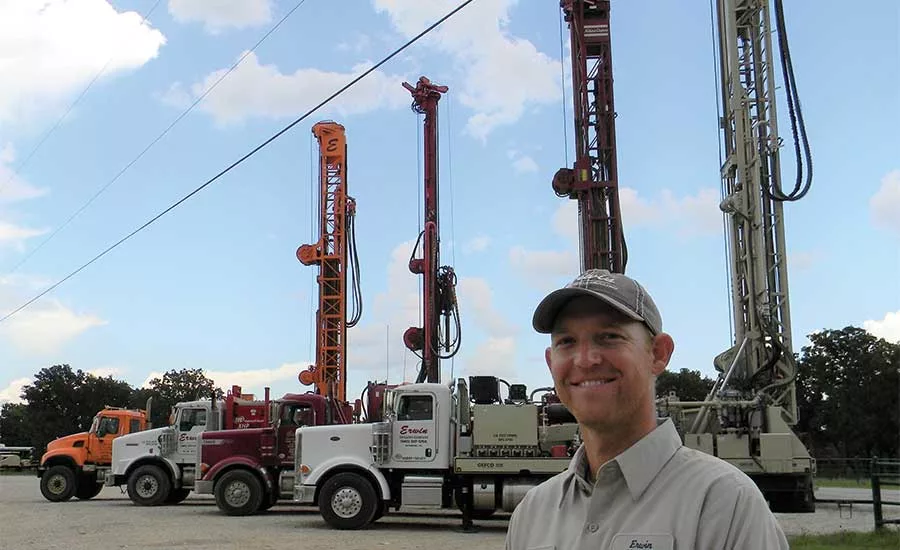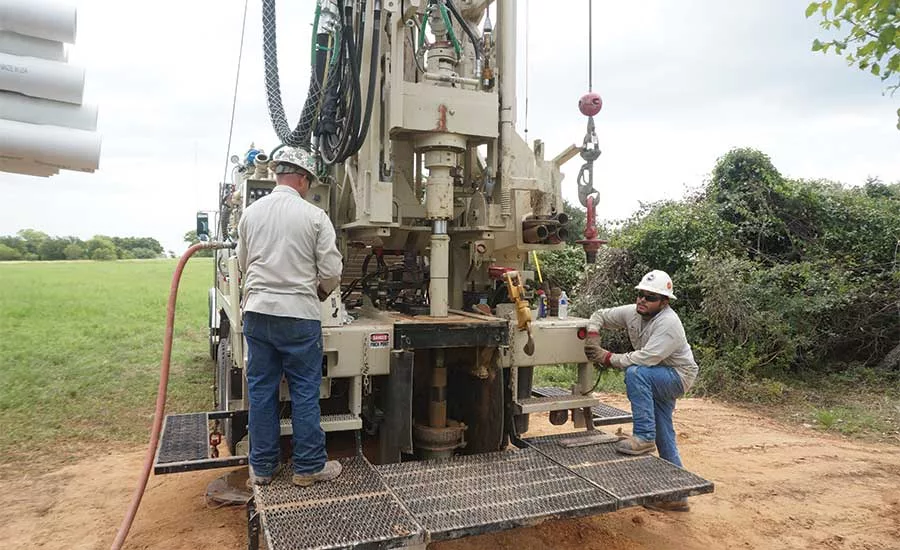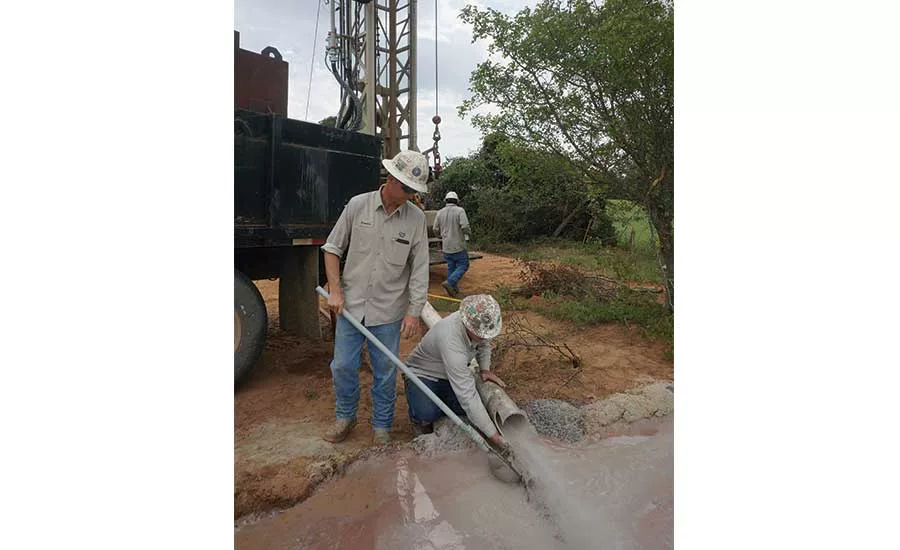You Know the Drill: Cathodic vs. Water Well Drilling

Brandon Erwin says finding reliable, hardworking people with a CDL is a challenge for his family’s drilling business. Source: Erwin Water Well Drilling

Erwin Water Well Drilling has a fulltime service crew and three drilling rigs. Usually, two rigs are in use every day. Source: Brock Yordy

There are pros and cons to both water well and cathodic protection drilling. While water well jobs keep the crew closer to home, the outcome of cathodic drilling is more predictable. Source: Brock Yordy
Brandon Erwin works as a rig hand and occasional driller at Erwin Water Well Drilling, located in Jacksboro, Texas. His father founded the company in 1985. The business has always been of interest to Erwin, but his path to drilling was not direct. “Like most kids graduating high school, I was under the impression that, in order to be successful, my best bet was to go to college and get a degree before beginning a career,” he explains.
After receiving a degree in industrial engineering, Erwin worked as a manufacturing engineer dealing with power transmission. He enjoyed the work, but didn’t feel like he was making a large enough impact. So, knowing his father was keeping busy, he joined the family business in 2012.
Erwin Water Well drilling spends most of its time drilling water wells for residential clients. It also specializes in cathodic protection and shallow oil well drilling. The company services Texas, Oklahoma and Louisiana. It started taking on cathodic projects around 10 years ago and Erwin says it isn’t the same as water well drilling.
For one, most water well jobs are located near company headquarters, while cathodic drilling jobs usually send the crew out of town for several days. The farther the jobsite, the less familiar the crew is with drilling conditions, and the more difficult it is to handle a breakdown or pick up additional equipment. Another difference Erwin notes is scheduling. “With water wells, scheduling is more flexible because you are communicating with one land owner or home builder, while cathodic jobs will be coordinated through a corrosion service company and ultimately a large oil and gas company with their own deadlines,” he explains.
However, Erwin finds cathodic drilling less concerning in terms of final results. When planning for a water well, his crew may not know the depth, volume or quality of water until drilling kicks off. With cathodic projects, hole depth and diameter are determined well in advance. “Once the anodes have been set, your job is complete without the same concerns that you have for a water well and how it will produce after completion,” Erwin says.
An important trend he notices, at least in his area, is that corrosion companies are offering fewer contracts to water well drillers for cathodic protection well services. They are purchasing their own rigs and hiring in-house help. Erwin says that the attempt to cut costs, in his opinion, leads to less productivity. He points out that the experience that companies like his offer and their knowledge of drilling conditions cannot be made up for through drilling equipment alone.
Q. What do you do and what keeps you coming back every day?
A. I work primarily on the same crew of three or four guys that drill a mix of water, oil and cathodic wells. Regardless of the type of hole that we are drilling, when a customer is satisfied and impressed with the way you have done your job, you take pride in what you are doing.
Q. What does a typical workday involve?
A. A typical workday can vary a great deal when drilling for a cathodic ground bed. On a good day, we arrive on location and immediately set up to drill. A pit would be dug either for drilling with mud or to catch cuttings if the hole can be drilled with air. It is also common to circulate mud from a portable pit or to blow cuttings on the ground, depending on the policies of the company we are working for. After the hole has been drilled, the hole would be logged to determine the anode spacing based on the resistivity of the soil. A vent pipe is placed down hole, as well as a tremie pipe if the coke breeze is required to be pumped. Anodes, which are most often cast iron or graphite, are run downhole individually and held in place by a wire lead throughout the depth of the hole. Next, coke breeze will be pumped through the tremie or dry poured from the surface, whichever the customer prefers. Once the coke breeze is set, the top portion of the hole can be plugged, the anode leads tied into a rectifier through a junction box, and the whole system grounded to the pipeline or well casing being protected.
… On the water well side, depending on where we’re going and how deep we’re drilling, we might schedule a couple a day, but typically it would be one. In the morning we load up our trucks with casing and gravel and water, then basically go where we’re going, coordinate with the land owners as far as timing and make sure we’re in the right location. Drilling the hole is basically the same as the others (cathodic and oil drilling). … We’ll drill and case and communicate with the land owner as far as what we’ve got. By the end of the day, maybe we’ve done one or two, or sometimes we’ll be on location a few days. Then we come back, coordinate the next day or next few days … and either load up that day or the following morning. … With an oil well, you basically load the amount of drill pipe you need to drill it. … Then we’ll have the casing delivered because it’s not something we supply. That would be a difference, but more or less when we show up to drill it’s the same throughout the three different types.
Q. What does it take to succeed in what you do?
A. As a company and as an individual, I think that you have to first care enough to do a good job for your customer and then know what it takes to do a good job for your customer.
Q. What do you wish you knew when you started?
A. Everything is easier when you are set up correctly for whatever job you are doing. Take the time to get your equipment set up and working well. If something breaks, fix it rather than limp along.
Q. What tool can you not imagine working without?
A. The job could not be done without the right drilling rig.
Q. What’s the best piece of advice you’ve been given?
A. Use the right tool for the job.
Q. How would you describe the present state of the industry?
A. Necessary. Cathodic protection is necessary for pipelines all over. As new pipelines are laid, new ground beds will be installed. When old ground beds are used up, new ground beds will replace them. Cathodic protection will be around for a long time.
Looking for a reprint of this article?
From high-res PDFs to custom plaques, order your copy today!



